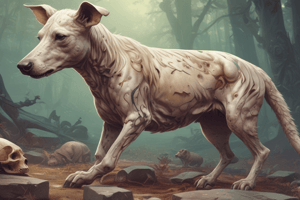Podcast
Questions and Answers
What is the primary texture associated with Fibrinous Bronchopneumonia?
What is the primary texture associated with Fibrinous Bronchopneumonia?
- Elastic
- Hard (correct)
- Nodular
- Firm
Which type of pneumonia is associated with rib imprints and lungs that fail to collapse when the thorax is opened?
Which type of pneumonia is associated with rib imprints and lungs that fail to collapse when the thorax is opened?
- Suppurative Bronchopneumonia
- Interstitial Pneumonia (correct)
- Granulomatous Pneumonia
- Embolic Pneumonia
Which of the following is a common etiology for Granulomatous Pneumonia?
Which of the following is a common etiology for Granulomatous Pneumonia?
- Mannhemia haemolytica
- Mycoplasma
- Systemic mycoses (correct)
- Actinobacillus pleuropneumoniae
What is the port of entry for Embolic Pneumonia?
What is the port of entry for Embolic Pneumonia?
Which color transition is typical in Fibrinous Bronchopneumonia?
Which color transition is typical in Fibrinous Bronchopneumonia?
Flashcards
Suppurative Bronchopneumonia
Suppurative Bronchopneumonia
Inflammation of the lungs with pus formation, mainly in the cranioventral area, caused by low-grade pathogens or aspiration.
Fibrinous Bronchopneumonia
Fibrinous Bronchopneumonia
Lung inflammation with fibrin (a protein) and necrosis, often from highly pathogenic bacteria or harsh aspirated material.
Interstitial Pneumonia
Interstitial Pneumonia
Inflammation of lung's alveolar walls (thin layer around air sacs) spread throughout the lungs, caused by various factors like viruses and toxins.
Granulomatous Pneumonia
Granulomatous Pneumonia
Signup and view all the flashcards
Embolic Pneumonia
Embolic Pneumonia
Signup and view all the flashcards
Study Notes
Suppurative Bronchopneumonia
- Occurs in the cranioventral region of the lungs
- Has a firm texture
- Color changes from red (acute) to grey (chronic)
- Cut surface: contains purulent exudate within bronchi
- Enters the body via the airways
- Caused by:
- Low-grade bacterial pathogens
- Mycoplasma
- Aspiration of bland materials
Fibrinous Bronchopneumonia
- Occurs in the cranioventral region of the lungs
- Has a hard texture
- Color changes from red to yellow to grey
- Fibrin is present on the pleural surface
- Cut surface contains fibrin and necrosis
- Enters the body via the airways
- Caused by:
- Highly pathogenic bacteria producing exotoxins:
- Mannhemia haemolytica
- Actinobacillus pleuropneumoniae
- Harsh aspirated materials
- Highly pathogenic bacteria producing exotoxins:
Interstitial Pneumonia
- Occurs diffusely throughout the lungs
- Has an elastic texture
- Cut surface is meaty
- Gross features
- Rib imprints
- Lungs fail to collapse upon opening the thorax
- Enters the body via the airways or the bloodstream
- Caused by:
- Viruses
- Toxins
- Type III Hypersensitivity reaction
- Toxicants
- Injury primarily occurs in the alveolar wall, specifically the endothelium or pneumocytes
- Histology: Thickening of the alveolar walls
- Difficult to diagnose macroscopically
Granulomatous Pneumonia
- Occurs in multifocal regions of the lungs
- Has a nodular texture (no pus)
- Cut surface contains granulomas
- Enters the body via the airways or the bloodstream
- Caused by:
- Mycobacterium spp
- Systemic mycoses
- Parasitic ova
- Trapped food particles (starch)
- Dead parasites
Embolic Pneumonia
- Occurs in multifocal regions of the lungs
- Has a nodular texture
- Enters the body via the bloodstream
- Color is red when acute and pale when chronic
- Caused by:
- Rupture of hepatic abscesses into the vena cava in cattle
- Vegetative endocarditis (right side of the heart)
- Jugular thrombosis
- Embolic foreign body (hair, septic emboli, etc).
Studying That Suits You
Use AI to generate personalized quizzes and flashcards to suit your learning preferences.




